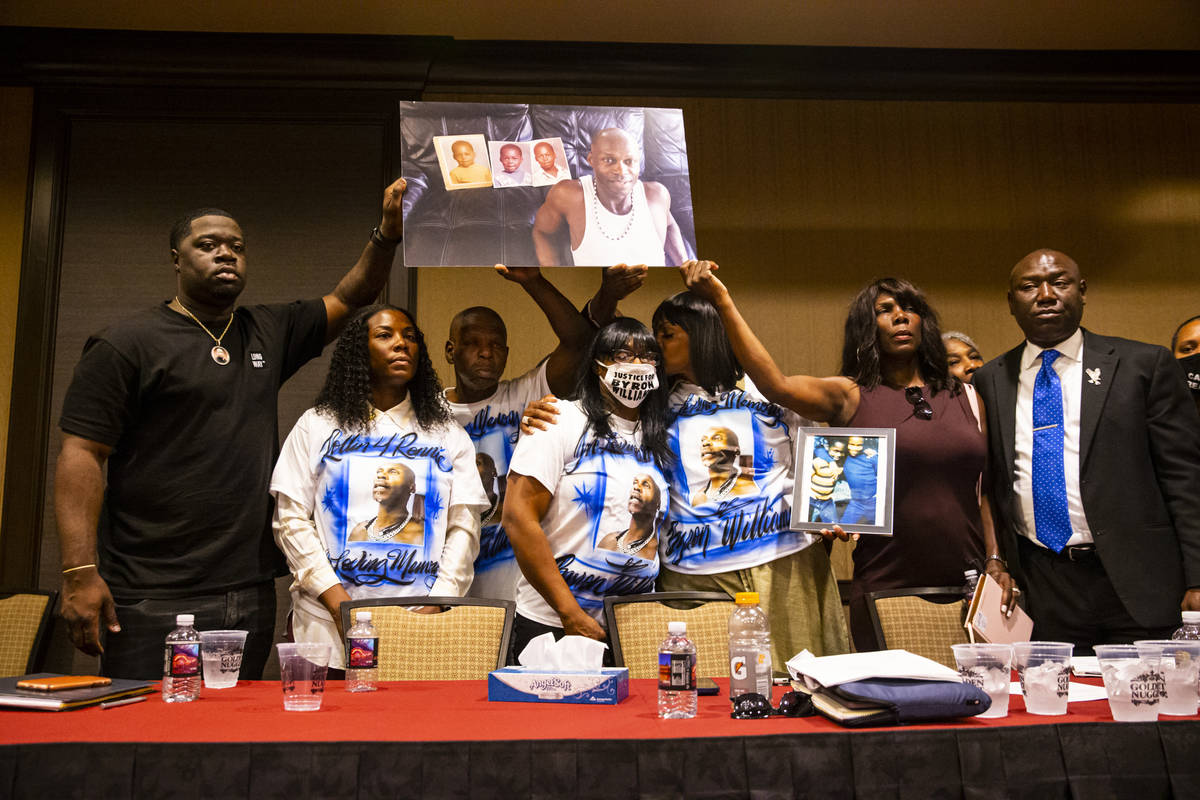George Floyd’s family helps shine spotlight on death of Byron Williams

The unarmed Black man’s dying cries — “I can’t breathe” — were ignored by police. It cost him his life.
“Your mind can go to Eric Garner. You can go to my brother, George Floyd,” Philonise Floyd said Thursday in a downtown Las Vegas conference room. “Nobody believed them. And now you look at what Byron Williams had to go through.”
Philonise Floyd, whose brother posthumously became a symbol for police reform, traveled to Las Vegas to stand alongside members of the Williams family as they announced a federal lawsuit in connection with Williams’ death on Sept. 5, 2019.
“It’s very important that they are here to show unity and solidarity,” civil rights attorney Ben Crump said of the Floyd family, “so that we can overcome this pattern and practice of police excessive use of force and implicit bias.”
The 43-page suit, filed Wednesday, names as defendants the city of Las Vegas, Clark County, the Metropolitan Police Department, Clark County Sheriff Joe Lombardo, and police officers Patrick Campbell, Benjamin Vasquez, Alexander Gonzalez and Rocky Roman.
Citing pending litigation, Metro and city officials declined to comment.
Clark County released the following statement to the Las Vegas Review-Journal: “Without weighing in on the specific allegations against Metro and its officers, we can say that the allegations in the complaint about the County’s supervisory responsibilities for the policies and procedures of Metro are completely inaccurate and will be immediately dismissed by a court.”
Crump famously represents the family of George Floyd. He was drawn to Williams’ case, he said, following the historic murder conviction of ex-Minneapolis police officer Derek Chauvin in Floyd’s death, due to the “glaring similarities” between the two cases.
“Just like we saw in Minneapolis, Minnesota,” Crump said, “we saw similar indifference and inhumanity here in the state of Nevada, in the city of Las Vegas, when Byron Williams was detained by the police and said ‘I can’t breathe’ 24 times.”
‘An atrocious act’
Williams’ deadly police encounter unfolded near Martin Luther King Boulevard and Bonanza Road, which is located in the Historic Westside, the heart of the city’s Black community.
Just before dawn, Williams was stopped by officers Campbell and Vasquez. After calling out to Williams, the officers announced a “code red” on Las Vegas police channels, according to the lawsuit, indicating that an emergency existed.
“LVMPD is alleging that the existing emergency that prompted the ‘Code Red’ was Byron Lee Williams riding his bicycle without a safety light,” the lawsuit states, “despite the fact that it was already becoming light outside.”
They chased Williams and later handcuffed him on the ground in a prone position as one of the officers pinned a knee on his head, shoulders and back. At least six other officers would join Campbell and Vasquez at the scene to provide assistance.
The officers mocked Williams as he pleaded with them for help, according to the lawsuit. Two of them high-fived.
Within an hour, Williams was dead from a combination of causes, including the “prone restraint” used by police and a methamphetamine overdose. His death was ruled a homicide by the Clark County coroner’s office.
Major gaps in the timeline of events leading up to his death remain unaccounted for nearly two years later. Some of the gaps in the case may never be filled.
“Las Vegas police committed an atrocious act to cover up what happened,” attorney Antonio Romanucci said. “They turned off their body-worn cameras — not for a minute, not for two minutes, but for over 10 minutes.”
Metro has not provided the family with an explanation as to why the officers turned off their cameras.
“We have asked and continue to ask for transparency,” said Williams’ niece, Teena Acree, who is a member of the Navy.
Trembling, she added: “I have served my country for over 20 years, and this is not what I expect. I expect America to be a beacon of hope for everyone.”
‘Byron’s life matters’
Williams’ dying cries were identical to those of George Floyd, yet his death has not received the same widespread attention.
The team of civil rights attorneys representing the Williams family say this is, in part, because a bulk of the footage available in the case was kept secret by Metro for more than a year.
“It underscores, again, Darnella Frazier’s cellphone video,” Crump said.
Frazier was 17 when she pulled out her cellphone and recorded the arrest and death of George Floyd, who was pinned under Chauvin’s knee for nearly nine minutes. Her video, which went viral, was a prominent piece of evidence in Chauvin’s trial.
“Do you think if there was cellphone video captured on the day that they did this to Byron Williams, that it wouldn’t have went viral?” Crump said. “That you wouldn’t have had people marching every day in Clark County, Nevada, just like in Minneapolis, Minnesota?”
The lawyer called video a “game changer.”
“Transparency leads to truth. Truth leads to justice,” Crump said.
Late last year, Clark County District Attorney Steve Wolfson decided that none of the officers involved in Williams’ death would face charges.
The man’s family and their attorneys hope Wolfson will reconsider. Wolfson did not respond to a request for comment Thursday.
“I am outraged that the police who took an oath to serve and protect us let our family down,” said Marcia Wells, another niece. “We want justice for my uncle.”
As the news conference came to an end, George Floyd’s brother and nephew raised a portrait of Williams and began to chant: “Byron’s life matters.”
Philonise Floyd outstretched his free arm, and one of Williams’ relatives collapsed into him.
Contact Rio Lacanlale at rlacanlale@reviewjournal.com or 702-383-0381. Follow @riolacanlale on Twitter.